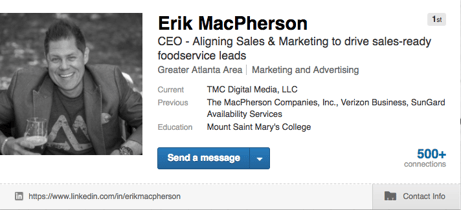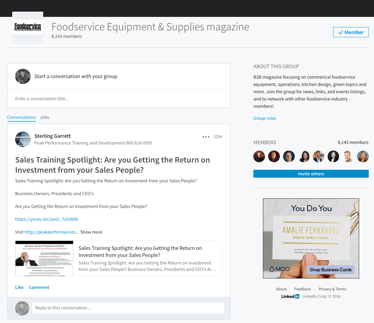The way we sell today is changing. Social media platforms like LinkedIn, Twitter, Facebook, and Instagram provide us so much valuable intel about a contact or a company that sales people should be better armed than ever to provide better value to a potential customer. Social media helps you build your personal brand and truly be known as a thought leader in your field. Whether it's prep before that first call, or at the end of the deal stage of closing the business, social selling is paramount for the ultimate success of today's sales executive.
One important note before we get into the meat & potatoes: do not SELL on social media. Do not go for the close. Social selling is about listening and learning about your prospects/customers. It's about educating and providing value. It's a long-term game - not for short gains.
So what should you be doing on a regular basis?
OPTIMIZE YOUR SOCIAL MEDIA PROFILES
 First and foremost, we're going to assume that you already have a profile for LinkedIn (at the very least). And if you don't, please go create profiles for LinkedIn, Twitter, Facebook, and Instagram now. The most important thing you can do to your profiles is to upload a really good profile photo of you. Not of your dog. You. Not with your significant other cropped out. But a professional looking headshot. Work some personality into it. Everyone is a decent photographer these days because of our iPhones. Or simply pay a professional a few hundred bucks. Look, using social media for business purposes means you are building your personal brand. People will either want to connect with you, or not. Having a quality profile photo will increase the amount of business connections. And if you don't have a photo, don't expect anyone to connect with you. It's like anything in life: you get what you give.
First and foremost, we're going to assume that you already have a profile for LinkedIn (at the very least). And if you don't, please go create profiles for LinkedIn, Twitter, Facebook, and Instagram now. The most important thing you can do to your profiles is to upload a really good profile photo of you. Not of your dog. You. Not with your significant other cropped out. But a professional looking headshot. Work some personality into it. Everyone is a decent photographer these days because of our iPhones. Or simply pay a professional a few hundred bucks. Look, using social media for business purposes means you are building your personal brand. People will either want to connect with you, or not. Having a quality profile photo will increase the amount of business connections. And if you don't have a photo, don't expect anyone to connect with you. It's like anything in life: you get what you give.
Take time to update your entire profile on each platform. You'll spend more time on LinkedIn being that it is the business professional social network. Twitter, on the other hand, requires you to be a little more creative as they limit the amount of characters you can use to describe yourself in the bio. Same holds true for Instagram. It is during your bio review that you will determine what your vibe is going to be like on social. What are your interests? What are your specialties? Self-awareness is important here. And look, don't be all things to all people.
At the end of the day, take time to review these platforms. Got some downtime during the Holidays? There's no better time then, right?
JOIN LINKEDIN GROUPS
 There are LinkedIn Groups for just about any topic you can think of. Search 'Foodservice Equipment' in Groups and you'll see several. Interested in Chain Restaurant Executives? There's a group for that. Join them. That's the first step.
There are LinkedIn Groups for just about any topic you can think of. Search 'Foodservice Equipment' in Groups and you'll see several. Interested in Chain Restaurant Executives? There's a group for that. Join them. That's the first step.
So you joined these groups, now what? Listen. Read. Listen more. Read more. Then start adding your comments. Comments that add value to the conversation. Comments that build credibility for your own personal brand. At some point, you'll even want to start your own conversation to get your group's feedback. But remember, NO selling. Always Be Teaching.
Over time, you'll begin to discover that some of your top prospects are engaging in these groups. You may even make new connections. You may remind one of your potential customers to get back in touch with you. The upside of being involved in LinkedIn Groups is unlimited.
SHARE CONTENT
One side of social selling is listening to others. Reading valuable content to arm you for your next sales call. On the other side is you sharing valuable content. But why?
Remember, you are building your personal brand as a subject matter expert, a thought leader in your field. To that end, sharing a valuable blog post you found on an industry trade rag online about how to increase the efficiency of your bar will grab your bar owner's attention. They will read it. They may comment on it. You are now engaging with a customer. You are building credibility.
.gif?width=480&height=238&name=giphy%20(7).gif) Start with your company's blog. Share new posts as they are published. Provided your company's blog is set up correctly, simply click on the share buttons, write a quick snippet as to why you are sharing it, and BAM, it's out there for your followers to see.
Start with your company's blog. Share new posts as they are published. Provided your company's blog is set up correctly, simply click on the share buttons, write a quick snippet as to why you are sharing it, and BAM, it's out there for your followers to see.
Another simple way to share content is to follow your company's social media accounts and share the content they publish within each social platform, especially on LinkedIn. This is so important because typically your personal reach is greater than the company's reach. So if 10 of you share a single post, you increase its exposure ten-fold. That valuable piece of content is going to grab much more attention than if it wasn't shared. It will drive quality traffic to the website. It will convert into a lead. It will become a deal that puts money into your pocket.
Lastly, like and comment on posts. Be engaged with people. Remember, you get what you give.
Ready to maximize your foodservice sales potential with social media? Sign up for the free course, Social Selling 101, and learn how to transform the way you sell.
